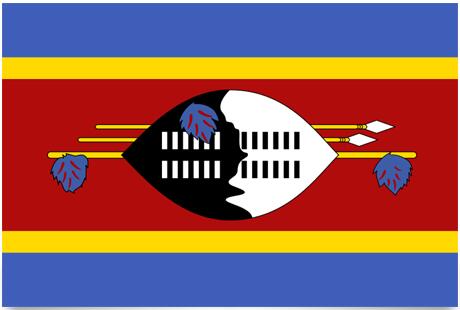Swaziland Flag and Meaning
Flag of Swaziland

Swaziland Flag Meaning
The two blue fields in the flag are a symbol of peace and stability, yellow is the country’s mineral wealth and crimson stands for the battles in history. The white and black color of the shield stands for the country’s white and black population who will live together in peace. The shield itself and the spear represent the country’s need to protect the population from enemies.
At independence on April 25, 1967, King Sobhuza II was sworn in as Swaziland’s head of state and the flag was hoisted for the first time. It was registered with the British Herald Office of the College of Arms in a slightly different variant in the design, on October 30, 1967.
Swaziland Overview
| Population | 947820 |
| Currency | Emalangeni |
| Area | 17.360 km² |
| Capital city | Mbabane |
| Population density | 51.8 residents/km² |
| HDI location | 121 |
The country can be geographically divided into 3 distinct regions. They are locally referred to as the higher, intermediate and lower ” veld ” (area), each of approximately the same extent. The western part is mountainous, the central part of the country consists of a high plain, and in the eastern part of the country is the lowland. The main products are sugar cane, citrus fruit and rice (with irrigation), cotton, corn (which is the basic food) and tobacco. In the lowlands, contaminated drinking water infections give rise to high infant mortality. The wilds of the country were exterminated in the first half of the 20th century by European hunters.
Simple authoritarian monarchy which, after South Africa, has the EU and the US as its closest trading partners. As one of the only European countries, Swaziland has an embassy in Denmark.
The people: The majority of the population (84.3%) belong to the Swazi ethnic group. The Zulus make up about 9.9%; tongues 2.5%; Indians (0.8%), Pakistanis (0.8%), Portuguese (0.2%) and others (1.5%).
Religion: No official religion exists. The majority of the population is Christian (77%). A large proportion of the population also practices traditional African religions (independently of being officially Christian).
Languages: Swazi and English (official); the ethnic minorities speak their own languages
Political Parties: The Popular Democratic Unity Movement (PUDEMO); Swaziland’s Progressive Party; Swaziland Democratic Alliance; Ngwanese National Congress for Liberation. All political parties and political activities were banned by Sobhuza II in 1973.
Social organizations: Swaziland’s Professional Federation; Swaziland Youth Congress.
Official Name: Umbuso weSwatini
Administrative division: 210 tribal areas, consisting of 40 traditional communities
Capital: Mbabane, 95,000 residents (2007).
Other important cities: Manzini, 22,500 residents Big Bend, 14,300 residents; Lobamba, 14,000 residents (2000).
Government: Simple monarchy. King Mswati III was crowned on April 25, 1986. Barnabas Sibusiso Dlamini has been prime minister since October 2008. Parliament has two chambers: the Assembly with 65 seats and the Senate with 30.
National Day: September 6 (Independence Day, 1968)
Armed Forces: 2,657 (1983).













































